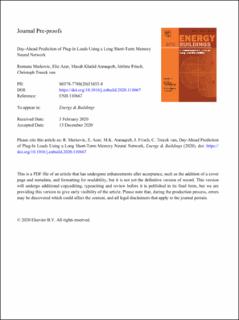| dc.contributor.author | Markovic, Romana | |
| dc.contributor.author | Azar, Elie | |
| dc.contributor.author | Annaqeeb, Masab Khalid | |
| dc.contributor.author | Frisch, Jerome | |
| dc.contributor.author | Treeck van, Christoph | |
| dc.date.accessioned | 2021-11-03T08:38:36Z | |
| dc.date.available | 2021-11-03T08:38:36Z | |
| dc.date.created | 2021-01-08T15:15:28Z | |
| dc.date.issued | 2021 | |
| dc.identifier.citation | Energy and Buildings. 2021, 234 . | en_US |
| dc.identifier.issn | 0378-7788 | |
| dc.identifier.uri | https://hdl.handle.net/11250/2827448 | |
| dc.description.abstract | The aim of this work is to develop and validate a miscellaneous electric loads (MEL) predictive model that does not require occupant-wise or building-wise model training nor model adaptation while achieving competitive accuracy. For that purpose, a long-short-term memory (LSTM) model was developed using monitored data from a research building located in Abu Dhabi, United Arab Emirates (UAE). In order to test the generalization capabilities of the proposed method, the model was evaluated using data from two additional buildings, a bank office building located in Frankfurt, Germany, and a university building in Ottawa, Canada. The results showed that the developed LSTM is applicable to the tested buildings without the need for occupant-wise or building-wise calibration, hence, addressing an important gap in the existing literature. In addition, a set of MEL predictive models from the literature, that are based on a Weibull distribution and Gaussian mixture models (GMM) are implemented and evaluated using the three identical data sets. The round-robin evaluation of existing MEL predictive models showed that the proposed LSTM model outperformed them especially when a combination of MEL and occupancy information was used as inputs. Finally, the neural network saturation was identified as the key challenge when developing an LSTM-based model for MEL prediction. | en_US |
| dc.language.iso | eng | en_US |
| dc.publisher | Elsevier | en_US |
| dc.rights | Attribution-NonCommercial-NoDerivatives 4.0 Internasjonal | * |
| dc.rights.uri | http://creativecommons.org/licenses/by-nc-nd/4.0/deed.no | * |
| dc.title | Day-Ahead Prediction of Plug-In Loads Using a Long Short-Term Memory Neural Network | en_US |
| dc.type | Peer reviewed | en_US |
| dc.type | Journal article | en_US |
| dc.description.version | acceptedVersion | en_US |
| dc.rights.holder | This is the authors' accepted manuscript to an article published by Elsevier. Locked until 19.12.2022 due to copyright restrictions. The AAM is made available under the CC-BY-NC-ND 4.0 license http://creativecommons.org/licenses/by-nc-nd/4.0/ | en_US |
| dc.source.pagenumber | 14 | en_US |
| dc.source.volume | 234 | en_US |
| dc.source.journal | Energy and Buildings | en_US |
| dc.identifier.doi | 10.1016/j.enbuild.2020.110667 | |
| dc.identifier.cristin | 1867895 | |
| dc.relation.project | Norges forskningsråd: 257660 | en_US |
| cristin.ispublished | true | |
| cristin.fulltext | preprint | |
| cristin.qualitycode | 2 | |

